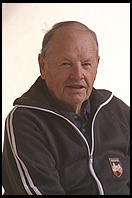
Canon EOS 70-200mm L Lenses (Updated)
by Philip Greenspun; created 2001
Site Home : Photography : Canon EOS 70-200mm L Lenses (Updated)

by Philip Greenspun; created 2001
Site Home : Photography : Canon EOS 70-200mm L Lenses (Updated)
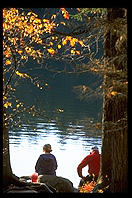 You cannot be a professional photographer without a high-quality, high-speed
telephoto zoom lens. Within the Canon EOS system, three such lenses are
available:
You cannot be a professional photographer without a high-quality, high-speed
telephoto zoom lens. Within the Canon EOS system, three such lenses are
available:
All of these provide very high image quality. All have ultrasonic motors and allow for full-time manual focus. This article is intended to help you decide among these three lenses.
 The f2.8 aperture is
essential to throw the background out of focus, especially for portraiture at
around 100mm. Note that the Canon L zooms are probably too sharp for flattering
glamour portraits of most people without either professional makeup at exposure
time or a little PhotoShop afterwards.
The f2.8 aperture is
essential to throw the background out of focus, especially for portraiture at
around 100mm. Note that the Canon L zooms are probably too sharp for flattering
glamour portraits of most people without either professional makeup at exposure
time or a little PhotoShop afterwards.
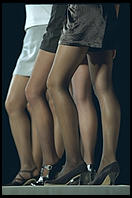 I was covering the
IMTA convention in Manhattan, where several thousand
aspiring fashion models converge on the Hilton with their agents/handlers/schools
(hoping to be discovered by agents in Japan, Europe, and maybe even New
York).
I was covering the
IMTA convention in Manhattan, where several thousand
aspiring fashion models converge on the Hilton with their agents/handlers/schools
(hoping to be discovered by agents in Japan, Europe, and maybe even New
York).
Ben, one of my 18 y.o. students from MIT the preceding semester, had to leave New York that week and, his going-away present was to come along as an assistant on this job. [I think he was satisfied; as we waded through the sea of 14-17 y.o. flesh at the juniors swimsuit competition, I had to repeatedly hoist his tongue back into his mouth.]
Every now and then we'd find a really beautiful contestant and drag her outside for better light. This usually attracted a crowd. At one point, I decided to change the 70-200/2.8L for a 50 macro. I started to unmount the 70-200 and then realized the camera bag wasn't open. In the back of my mind, I didn't trust Ben to do anything so I moved my hands to open the camera bag. The month-old 70-200/2.8L (non-stabilized) dropped from waist height (1 meter) onto concrete with a horrifying "thunk".
No damage.
[Of course, the gods punished me for writing the above. In October 1997, I was in Northeast California and the lens became hard to focus manually (but was fine in AF mode). A couple of days later, I noticed that the front and back halves of the lens were no longer securely connected. It went to Canon for a $100 worth of service and I'm still using the lens in 2001.]
Autofocus with these lenses is nearly instant. This makes the 70-200s great lenses for street photography, even if somewhat obtrusive. Despite the lenses' near-instantaneous focusing, Canon included a focus range switch. The settings are "1.5m to infinity" and "3m to infinity". In theory, if you were photographing lions in Africa, you'd want the 3m-infinity range set so that when the camera lost focus it would spend less time hunting. In practice, what happens is that I always knock the switch to the 3m-infinity range by mistake. Then I'm photographing my friend's kid on a carousel and wondering why continuous AF tracking is working so poorly. I waste about five frames before I think to take my eye away from the camera and reset the AF range switch. Canon bodies should have a custom function to disable these lens switches but they don't.
Above images were taken with continuous AF, EOS-5 body set to choose by itself among the 5 AF sensors. Non-stabilized 70-200/2.8L. Fuji Super G + 400 neg film..
You turn a ring to zoom this lens. If you have the lens on a tripod pointing down a bit, that means that the focal length doesn't creep as it would with a push-pull zoom. Much nicer. The Canons also come with a removable tripod collar. The bayonet plastic lens hoods work well also.
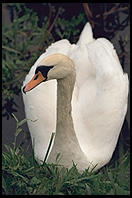 These lenses are so
good in terms of flare, contrast, and sharpness that it is tough to find anything
to criticize. However, if you look at Lens Work II, the book of
optical formulae published by Canon, it is pretty clear that any of the prime
telephotos (including special-purpose lenses like the 100 macro and the 135 SF)
outperform the 70-200 in terms of modulation transfer function
(resolution/contrast). So if you are obsessive about image quality, you can save
yourself a lot of cost and weight by going with an 85/1.8, 100/2, 100 macro,
135/2.8SF, 135/2L, 180 macro, 200/1.8, or 200/2.8.
These lenses are so
good in terms of flare, contrast, and sharpness that it is tough to find anything
to criticize. However, if you look at Lens Work II, the book of
optical formulae published by Canon, it is pretty clear that any of the prime
telephotos (including special-purpose lenses like the 100 macro and the 135 SF)
outperform the 70-200 in terms of modulation transfer function
(resolution/contrast). So if you are obsessive about image quality, you can save
yourself a lot of cost and weight by going with an 85/1.8, 100/2, 100 macro,
135/2.8SF, 135/2L, 180 macro, 200/1.8, or 200/2.8.
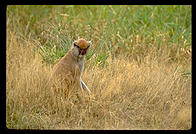 Unlike its 80-200/2.8
predecessor, all of the Canon 70-200 L lenses are compatible with the Canon 1.4X
and 2X teleconverters. The photo at right was taken with the 70-200/2.8L and 1.4X
converter (Kodak E100 film, EOS-5 body, ARCA Swiss ballhead on Gitzo carbon fiber
tripod). Note that the resulting effective 300mm lens wasn't really long enough
for this medium-sized animal, even though his home is the Seattle Zoo. Image
quality is quite high though you are definitely going to lose a lot of sharpness
with a 2X converter.
Unlike its 80-200/2.8
predecessor, all of the Canon 70-200 L lenses are compatible with the Canon 1.4X
and 2X teleconverters. The photo at right was taken with the 70-200/2.8L and 1.4X
converter (Kodak E100 film, EOS-5 body, ARCA Swiss ballhead on Gitzo carbon fiber
tripod). Note that the resulting effective 300mm lens wasn't really long enough
for this medium-sized animal, even though his home is the Seattle Zoo. Image
quality is quite high though you are definitely going to lose a lot of sharpness
with a 2X converter.
Our first tests of the 70-200/2.8L IS lens were very encouraging. Here are some images taken with a Canon D30 body, standing up, with the zoom set to 200mm, of a building in New York City:
| unstabilized | stabilized | |
|---|---|---|
| 1/15th |

|
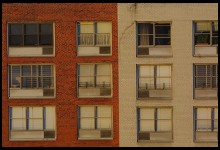
|
| 1/30th |
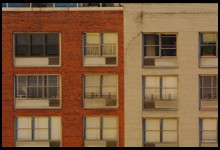
|
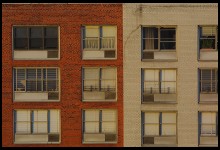
|
| 1/60th |

|

|
Here are some images taken while sitting down of a flower, also at 200mm:
| 1/15th | 1/30th | 1/60th |
|---|---|---|
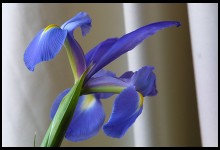
|
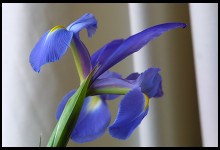
|

|
The bottom line seems to be that acceptable results are obtainable at 1/30th of a second. That's 3 f-stops better than you'd expect from the "1/focal-length" rule of thumb.
If you're going backpacking with a tripod, save your back and get the 70-200/4L. For studio portraits that will be lit by electronic flash, get the 70-200/2.8L (non-stabilized). For all-around high-performance, you definitely want the IS version of the 70-200/2.8L.
Only if you're on an extremely tight budget should you consider the anicent Canon EOS 80-200/2.8L lens. This lens does not allow for full-time manufaul focusing. Also, the old lens design also is incompatible with teleconverters.
I like using the 70-200 on a tripod to isolate patterns in landscapes. I'll have the lens stopped down to at least f/11 for wide depth of field but I still appreciate the f/2.8 maximum aperture because it keeps the viewfinder bright and makes it easy to focus manually.
Here are some snapshots from my excursions to foliage country...
And a few from California...
And a few from Italy...
Text and pictures copyright 1995-2001 Philip Greenspun. Top photo is Brother Adrian at Mission Santa Barbara.